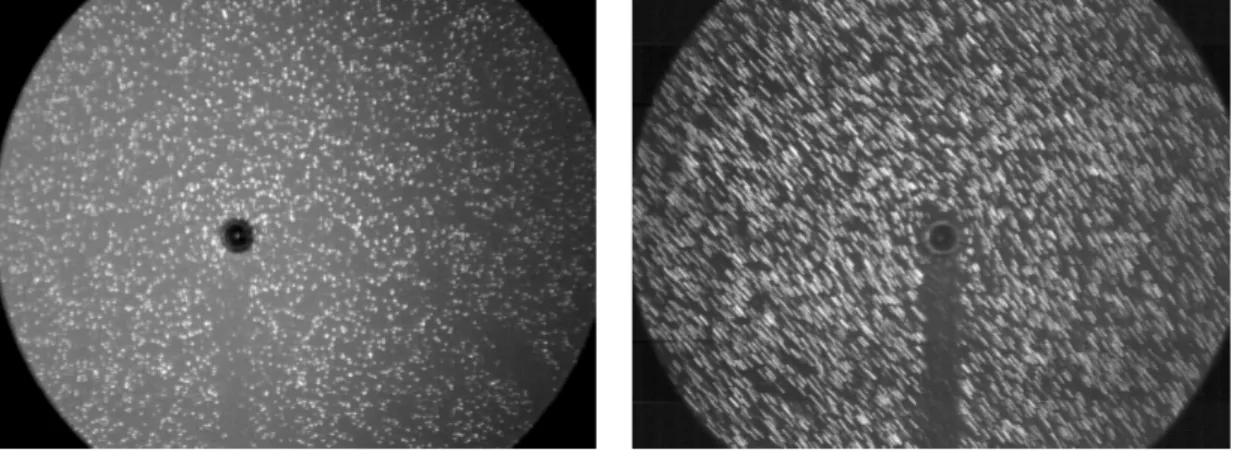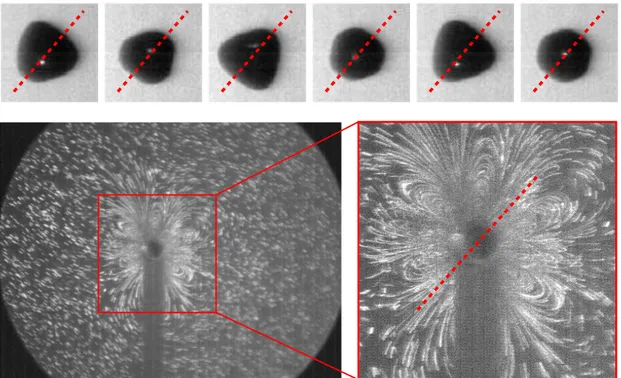HAL Id: hal-02096204
https://hal.archives-ouvertes.fr/hal-02096204
Submitted on 11 Apr 2019HAL is a multi-disciplinary open access
archive for the deposit and dissemination of sci-entific research documents, whether they are pub-lished or not. The documents may come from teaching and research institutions in France or abroad, or from public or private research centers.
L’archive ouverte pluridisciplinaire HAL, est destinée au dépôt et à la diffusion de documents scientifiques de niveau recherche, publiés ou non, émanant des établissements d’enseignement et de recherche français ou étrangers, des laboratoires publics ou privés.
Experimental investigation of microstreaming induced
by free nonspherically oscillating microbubbles
Sarah Cleve, Matthieu Guédra, Cyril Mauger, Claude Inserra, Philippe
Blanc-Benon
To cite this version:
Sarah Cleve, Matthieu Guédra, Cyril Mauger, Claude Inserra, Philippe Blanc-Benon. Experimental investigation of microstreaming induced by free nonspherically oscillating microbubbles. 21st Inter-national Symposium on Nonlinear Acoustics (ISNA 21), Jul 2018, Santa Fe, NM, United States. pp.045030, �10.1121/2.0000900�. �hal-02096204�
Proceedings of Meetings on Acoustics
Experimental investigation of microstreaming induced by free nonspherically oscillating
microbubbles
--Manuscript
Draft--Manuscript Number:
Full Title: Experimental investigation of microstreaming induced by free nonspherically oscillating microbubbles
Article Type: 21st ISNA Corresponding Author: Sarah Cleve
Laboratoire de mecanique des fluides et d'acoustique Villeurbanne, Lyon FRANCE
Order of Authors: Sarah Cleve Matthieu Guédra Mauger Cyril Claude Inserra Philippe Blanc-Benon
Abstract: Microbubbles exposed to a sufficiently strong ultrasound field can show nonspherical oscillations called surface modes. In the vicinity of the bubble surface, these
oscillations induce a slow mean flow named microstreaming. Microstreaming plays an important role in medical applications such as sonoporation as well as in engineering applications such as micromixing. A better understanding of the induced flows will hence be beneficial to a large number of applications. Recent studies mainly report on microstreaming induced by bubbles resting on a solid boundary. The observation of microstreaming around a single, free bubble is challenging, because several experimental difficulties have to be overcome: Avoidance of translational instabilities, obtainment of a steady-state behavior maintaining surface modes, correct choice of tracer particles, and correlation between fast temporal bubble dynamics and relatively slow microstreaming. We present an experimental setup, that accomplishes the simultaneous visualization of microstreaming and bubble dynamics. Different streaming patterns can be observed.
Section/Category: Physical Acoustics
INTRODUCTION
An oscillating cavitation bubble can set the surrounding fluid into motion, a phenomenon called mi-crostreaming. Most experimental studies on cavitation-induced streaming flows focus on bubbles resting on solid boundaries1 as this facilitates the control of the bubble size and bubble location, as well as fluid motion observation. For such bubbles, it has been observed that streaming velocities undergoing shape os-cillations are much larger than the velocities induced by bubbles with radial oscillating and translational motion.2 The main drawback with bubbles resting on a solid boundary is the assessment of the bubble dynamics, usually empirically determined due to the huge complexity of the contact line dynamics leading to nontrivial interaction of shape and volume oscillations.3 While these conditions are of interest for mi-crofluidic transport applications, therapeutic microbubbles are usually free in the liquid. For free bubbles, nonspherical oscillation dynamics has been widely studied theoretically,4, 5 and is experimentally studied even for strong acoustic pressure where nonlinear interactions between modes occur.6 Moreover, all theo-retical developments on microstreaming patterns consider oscillating microbubbles in infinite liquid.7–9 In the present study an experimental technique is presented for the achievement of controlled microstreaming of a free, nonspherically oscillating microbubble.10Bubble coalescence technique is used to trigger surface modes of trapped microbubbles. This technique leads to steady-state oscillations of a given shape mode over a sufficiently long time scale, allowing the tracking of fluid motion with tracer particles. Streaming patterns are obtained and their appearance can be correlated to the parametrically excited surface modes.
EXPERIMENTAL SETUP
A schematic drawing of the experimental setup and its different operational modes is presented in Fig. 1. Experiments are conducted in an 8-cm-edge cubic water tank filled with bidistilled undegassed water. A standing ultrasound field is created by an ultrasonic plane transducer (SinapTec®, diameter of the active area 35 mm), which is attached to the bottom of the tank. The voltage amplitude of the transducer is varied between 1 and 10 V, no gain amplifier is used. The driving frequency is set to 31.25 kHz for all experiments, corresponding to a resonant radius Rres ⇡ 104 µm according to Minnaert’s theory.11 All bubbles studied in the current work are below resonant size and will be driven towards pressure antinodes due to primary Bjerknes forces. Single bubbles are nucleated by short laser pulses ( = 532 nm, second harmonic of a Nd:YAG pulsed laser, New Wave Solo III, 6 ns pulse duration). Experiments are captured with a CMOS camera (Vision Research® V12.1) equipped with a 12⇥ objective lens (Navitar®). It is
pos-a) bubble coalescence water tank US transducer pulsed laser focusing lens nucleated bubble trapped bubble b) bubble dynamics camera LED nonspherically oscillating bubble c) microstreaming camera laser sheet PIV particles
Figure 1: Experimental setup using the following steps: a) triggering of surface modes by bubble coales-cence, b) recording of the bubble dynamics, c) recording of the microstreaming.
Figure 2: Fluorescent tracer particles around two bubbles oscillating in a purely spherical mode. Both images correspond to a superposition of 100 snapshots covering 0.25 s. Left: No motion of the tracer particles can be observed. Right: A parasite mean flow can be observed in the whole image. However, this flow is not linked to the bubble motion.
sible to switch between two operating states: bubble dynamics and microstreaming. For the visualization of the bubble dynamics, backlight illumination with a light-emitting diode (LED) is used. A frame size of 256⇥ 256 pixels and a frame rate of 67.065 kHz are chosen. For the visualization of microstreaming, red fluorescent polymer microspheres (diameter, 0.71 µm, Duke Scientific) are added. The particles are illu-minated by a continuous thin laser sheet ( = 532 nm). A frame size of 1024 ⇥ 768 pixels and a frame rate of 400 Hz are chosen. A fast switch between the two operating states allows for information on bubble dynamics as well as microstreaming.
ENSURING LONG-TIME STABLE NONSPHERICAL OSCILLATIONS
One of the main difficulties when assessing microstreaming induced by a free bubble is to keep the nonspherically oscillating bubble in a steady-state regime over a sufficiently long time. In order to meet this requirement, bubble coalescence is used to trigger surface modes:10 two bubbles encounter each other and merge into a new single one of equilibrium radius Re. Depending on Redifferent surface modes n of natural frequency !2 = (n 1)(n + 1)(n + 2) /(⇢R3
e)can be triggered if the applied acoustic pressure exceeds the parametric threshold of the nthmode. Furthermore, bubble coalescence technique enables the control of the axis of symmetry which rules the oscillations of the bubble on the zonal spherical harmonics. The bubble interface is then described by the coordinate rs(✓, t) = R(t) +P1n=2an(t)Pn(cos(✓)), where R(t)stands for the volume mode amplitude, an(t)for the respective surface mode amplitude of the mode n, and Pn denotes the Legendre polynomial of order n. By ensuring axisymmetric nonpsherical oscillations, and by placing the axis of symmetry in the focal plane of the camera, we can hence observe the bubble and its associated streaming, which are 3D phenomena, in the 2D focal plane of the camera without bias.
EXAMPLE OF BUBBLE DYNAMICS AND MICROSTREAMING RECORDING
When two bubbles coalesce at a given pressure amplitude below the parametric threshold, only spherical oscillations remain and no effect on the surrounding fluid is observed (see Fig. 2, left). Under certain circumstances, an overall mean flow can be observed, see Fig. 2 on the right. This flow is however not linked to the bubble motion, as it appears even without the presence of a bubble. Possible reasons are the remaining inertial effects of the water introduced in the tank and buoyancy forces due to the heating of the
Figure 3: Above: Bubble dynamics of bubble oscillating in a mode 3, represented by consecutive snap-shots over two acoustic periods (0.064 ms). The axis of symmetry is indicated by the dashed red line. Below: Streaming pattern induced by this bubble. The image corresponds to a superposition of 100 snapshots covering 0.25 s. The width and height of the red box are 0.7 mm.
laser sheet. As streaming is a relatively slow effect, care has to be taken that no too strong influence of the parasite background flow appears.
Microstreaming only appears when translational or nonspherical oscillations occur in addition to the volume oscillations. Several recordings of nonspherically oscillating bubbles generated by coalescence have been made. An exemplary result is shown in Fig. 3 for a 70 µm radius bubble in a 15 kPa ultrasound field, thus above the parametric threshold amplitude of 8 kPa for the n = 3 surface mode. Consecutive snapshots on the bubble dynamics on two acoustic periods reveal the subharmonic behavior for nonspherical oscillations. When looking at the induced microstreaming pattern, the trajectories of the particles can be visualized by streak photography (Fig. 3). All trajectories together form a steady streaming pattern. In the presented case, six lobes can be distinguished in agreement with the multipole radiation of the n = 3 surface mode. The correlation between the microstreaming pattern and the bubble dynamics is ensured by capturing bubble dynamics before and after tracking of particle motion. In particular, this can allow correlating the microstreaming velocities to the surface mode amplitudes. A detailed discussion is however beyond the scope of the present paper. To obtain the streaming velocities, particle image velocimetry can be used. For the surface mode amplitudes of the nonspherical oscillations, a modal decomposition over the Legendre polynomials taking into account the axis of symmetry as depicted in Fig. 3 is needed.
CONCLUSION
A setup and exemplary results of microstreaming around nonspherically oscillating bubbles are pre-sented. By taking advantage of bubble coalescence in a standing ultrasound field, long-time stable non-spherical oscillations of microbubbles are obtained. Successive recordings of fluid tracers motion and
oscillations of the acoustic time scale allows associating streaming patterns to the corresponding bubble dynamics.
ACKNOWLEDGMENTS
This work was performed within the framework of the Labex CeLyA of the Universit´e de Lyon, within the program Investissements d'Avenir (ANR-10-LABX-0060/ANR-11-IDEX-0007) operated by the French National Research Agency (ANR).
REFERENCES
1P. Marmottant and S. Hilgenfeldt, “A bubble-driven microfluidic transport element for bioengineering”, Proc. Natl. Acad. Sci. U.S.A.101(26), 9523 (2004).
2P. Tho, R. Manasseh and A. Ooi, “Cavitation microstreaming patterns in single and multiple bubble sys-tems”, J. Fluid Mech.576, 171 (2007).
3S. Shklyaev and A.V. Straube, “Linear oscillations of a compressible hemispherical bubble on a solid substrate”, Physics of Fluids20, 052102 (2008).
4S.J. Shaw, “Translation and oscillation of a bubble under axisymmetric deformation”, Physics of Fluids 18, 072104 (2006).
5A.A. Doinikov, “Translational motion of a bubble undergoing shape oscillations”, J. Fluid Mech. 501, 1 (2004).
6M. Gu´edra, C. Inserra, C. Mauger and B. Gilles “Experimental evidence of nonlinear mode coupling between spherical and nonspherical oscillations of microbubbles”, Phys. Rev. E 94, 053115 (2016). 7A. Maksimov, “Viscous streaming from surface waves on the wall of acoustically-driven gas bubbles”,
European Journal of Mechanics-B/Fluids26, 28 (2007).
8T. Spelman and E. Lauga, “Arbitrary axisymmetric steady streaming: flow, force and propulsion”, Journal of Engineering Mathematics 105, 31 (2017).
9A. Doinikov and A. Bouakaz, “Acoustic microstreaming around a gas bubble” J. Acoust. Soc. Am. 127, 703 (2010).
10S. Cleve, M. Gu´edra, C. Mauger, C. Inserra and P. Blanc-Benon, “A method for triggering surface modes by bubble coalescence”, J. Acoust. Soc. Am.141, 3736 (2017).
11M. Minnaert, “XVI. On musical air-bubbles and the sounds of running water”, The London, Edinburgh, and Dublin Philosophical Magazine and Journal of Science, 1933.


